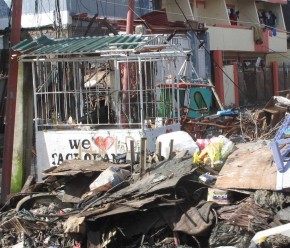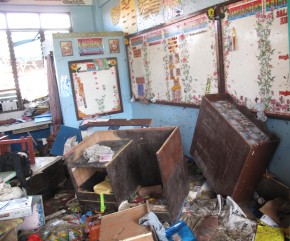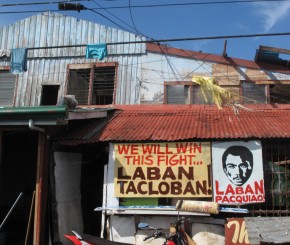It was the images of utter devastation and destruction in Tacloban which put Typhoon Haiyan at the top of the news stories in the UK. A giant cargo ship hurled like a match box by the ferocious force of the storm surge into the middle of the city, images of an urban centre razed to the ground as far as the eye could see.

When you work in the development/humanitarian world, you try your best to portray the people you are trying to work with and help not as apparently passive victims, but as the participants and actors that they are. As individuals and people, families and communities in their own right, not just unfortunate secondary sufferers of the unintended effects of some war or natural disaster in a far-off part of the world. More than 2 weeks after the Typhoon struck however, driving through Tacloban, we were all staring out the windows, lost for words at the seemingly post-apocalyptic scenes outside. Everyone assured me that Tacloban was hugely improved since this time a week ago – the main roads had been cleared, the airport largely functional, aid and supplies were flying in, including on the RAF Hercules we hitched a lift in on. To the untrained eye, however, scenes were still of Biblical destruction.

At the airport itself, Australian and British medical teams were based in a tent, and many of the other NGOs, UN agencies and military had set up camp off the edge of the airfield, living out of tents in lieu of any better accommodation in town still standing. Helicopters, Ospreys and military aircraft were flying in and out of the runway constantly, stacks of food and supplies sent from around the world were piling up on the apron of the runway. The airport itself was close to the sea, and beyond it, the area around had been worst affected by the Typhoon’s storm surge. As far as the eye could see, it was still total devastation: bamboo huts or brick buildings, it seemed to have made no difference, absolutely everything seemed to be have been completely laid to waste.

Driving further down the road some buildings remained standing, but as you began to be able to distinguish between what was still identifiable and what had been wholly obliterated by the storm, it became even more disconcerting. Lorries flung upside down, concertina-ed sheets of metal fired into the sides of building, cars sunk headfirst into the ground, uncollected body bags still lying on the side of the street. Newspaper kiosks with ‘We love Tacloban’ incongruously painted on the side crushed by felled power lines and shattered roof tiles.
Gradually some method within the madness began to reveal itself – piles of detritus on rubbish along the side of the road seemed to have been deliberately collected for disposal; elsewhere you could see people roaming the mounds of rubble searching for salvageable items. Then further down the road you could see the results – a sofa someone was hoping would still be useable, a television scavenged from the wreckage which might just still work. Signs of life were returning to the town - vendors were selling bananas and barbequing meat kebabs, people queued patiently outside a renovated ATM. Business seemed quiet, but it was early on a Sunday morning, and many Filipinos seemed to be heading to Churches for mass – some of the few buildings that had seemed relatively intact.

I had flown with some of DFID’s team and our Secretary of State Justine Greening into Tacloban on an RAF C17 which was delivering aid including food, generators and a Land Rover (as we saw many forms of transport in Tacloban had been destroyed) to UK aid partners Save the Children. We went to visit a ‘child friendly space’ set up by them inside a former school in the centre of the city. I say former because the tidal wave had washed right through the school – 1 of the staff pointed out the 2 metre high water mark in one of the classrooms. The children’s teacher, along with many of her pupils and her family were camped out in the school because their homes had been destroyed. The school had been badly damaged – she explained that as the storm surge hit, she had had to sprint upstairs with the children, then break the windows to let it out the water as it rose to the level of the first floor. What had once presumably been the playground was still inches deep in water and littered with broken detritus from the school. Inside most of the classrooms, shattered desks and ruined textbooks littered the classrooms, the star chart showing the kids’ progress at English and Maths had somehow survived, forlornly pinned to the wall. It wasn’t exactly the ideal place for them all to stay, but they had nowhere else.

I realise I have failed in my account above, in making an event itself bigger than people who are part of it, but actually seeing Tacloban for yourself, even 2 weeks afterwards, was shocking. But driving along the same route, back to the airport, I felt I could already see it in a different way. Government workers in hard hats were out early on Sunday morning supervising JCBs clearing debris, improvised traffic lights had been installed to control the newly cleared main roads, and stalls and were shops beginning to roll up their metal shutters to open for business. On the corner of one street, a sign promoting the Philippines’ national hero, boxer Manny Pacquiao, and his hotly anticipated bout later that evening read “We will win this fight…LABAN (fight), TACLOBAN!” And everywhere I’ve been in the Philippines, that’s what it feels like people are doing.
-----------------------------------------------------------------------------------
For the latest updates on the UK's response to Typhoon Haiyan: https://www.gov.uk/government/news/typhoon-haiyan-latest-updates-on-uk-aid

2 comments
Comment by Genista posted on
You are doing a terrific job in such difficult circumstances.
Comment by Garfield posted on
What's up, I read your blog regularly. Your story-telling style is witty, keep it up!